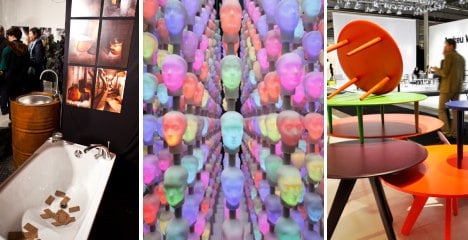During the first two weeks of February, the Swedish capital will be reveling in the throes of Scandinavian creativity. Stockholm Design Week (SDW) is kicking off just as Stockholm Fashion Week wraps up.
Over the last few years, the Stockholm Furniture Fair (SFF) has morphed from a trade fair targeting retailers and manufacturers to a city-wide, weeklong celebration of design with a number of events and exhibitions open to the general public.
Running from February 7th-13th, Stockholm has earned its place in the international design circuit along with larger European capitals such as London and Milan.
The traditional furniture fair (February 8th-12th) is still located at Stockholm International Fairs (Stockholmsmässan) in the Stockholm suburb of Älvsjö. The fair is open for trade visitors Tuesday through Friday, and open to the general public on Saturday, February 12th.
Highlights of the fair include Greenhouse, which features the work of independent, up-and-coming designers and students. In conjunction with Greenhouse, visitors can see the jury-selected ung8 touring exhibition, aimed at young Swedish designers.
The fair’s Guest of Honour is Paris-based designer Arik Levy, originally from Israel, who has created furniture and lighting for a number of Swedish and international manufacturers.
“The fair has become the most important design event in the Nordic region as well as internationally. More and more international companies and designers are also choosing to exhibit in Stockholm,” says Daniel Golling, editor-in-chief of Form, a new Swedish design and architecture magazine that will be launched at Berns on Wednesday, February 8th.
Stefan Nilsson, trend analyst and curator at Designgalleriet design gallery, concurs.
“Stockholm Furniture Fair is is still the main attraction during Stockholm Design Week, but just as Milan or London have…become more than just fairs…Stockholm is now booming with creativity and lust for design. I guess all fair weeks need a creative side to the design aspect, so that it’s not all about contract furniture,” he says.
Nilsson adds that two major initiatives, Design in Vasastan and Stockholm Design District (Södermalm), have provided impetus to SDW. Both neighbourhoods boast clusters of design studios and galleries, and provide an alternative to the fair in the suburb of Älvsjö.
The emergence of “design districts” in Stockholm is parallel to what has occurred in Milan, perhaps the grandfather of all European design weeks, with neighbourhoods such as Zona Tortona becoming the venue of choice for more cutting edge, experimental design.
Nilsson is one of the founders of Design in Vasastan.
“We saw what was happening on an international level. People came to Stockholm for the fair but wanted more. You spend one day at the fairgrounds but then you want to see something else,” he explains.
He adds that SDW is more about creativity than design: “See it more as an arty project rather than ideas on how to furnish your home. The things in the city are more creative and experimental than just trying to find the perfect couch for your living room.”
Some of the more high profile events during the SWD include Form Us With Friends by design studio Form Us With Love. The exhibition, featuring the work of ateljé Lyktan, Bolon, Santa & Cole, Träullit and Westal, will be held in a church at a secret location in central Stockholm.
“Among pulpits and pillars, steaming fresh products and projects are presented together by five of our manufacturing friends from the design industry,” says designer Petrus Palmér.
Other highlights include 20 Designers at Biologiska, an exhibition featuring the work of designers from more than 15 countries. Held at the Biologiska Museum, the show “is about evolution, diversity, and universality, where contemporary design, art and light is housed in an unexpected context.”
Designgalleriet will be exhibiting the work of Italian designer Luca Nichetto during the week. Several hotels will also host small shows, including Light Jockeys at Nordic Light Hotel, Norway Now at Clarion Sign Hotel, and Check In at Hotel Birger Jarl.
While Stockholm Design Week is becoming more international, Swedish design is still at its core.
Nilsson doesn’t believe that Swedish design has gotten too far away from its past.
“Swedish design will always have roots in sleek minimalistic design. Swedes tend to work with these sort of unornamented objects. If you look at typical Swedish design you will also find that it is fairly affordable (compared to Italian equivalents) and functional,” he says.
Palmer agrees that Scandinavian sensibility prevails.
“Swedish design is a lot about sound choices and responsibility,” he says.
Golling weighs in on the hottest Swedish designers right now: “Front is showing their magazine rack for Kartell. Jens Fager did the exhibition architecture for Greenhouse at the fair. Luca Nichetto, who spends half of his time in Sweden, will be at Designgalleriet. Monica Förster’s joint exhibition with graphic designer Björn Kusoffsky at Svenskt Tenn’s temporary locale is worth a trip to Östermalm.”
Golling must be on the right track as Nilsson confirms two of his top picks.
“Front, Monica Förster and Claesson, Koivisto Rune are the best known designers on an international level. If you visit Stockholm during Stockholm Design Week, try to pass by the new hotel of Nobis designed by Claesson Koivisto Rune. Perhaps the coolest design place we have in the city right now,” he says.




 Please whitelist us to continue reading.
Please whitelist us to continue reading.
Member comments